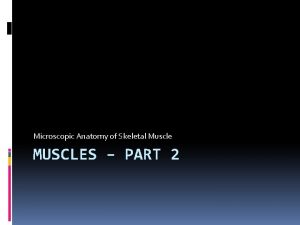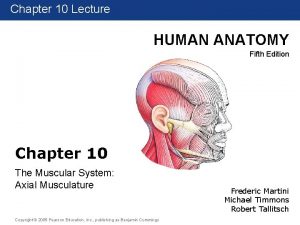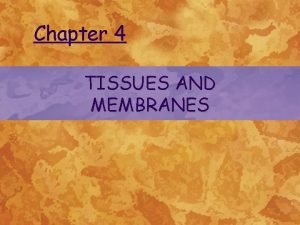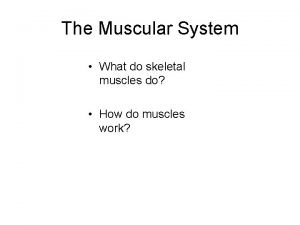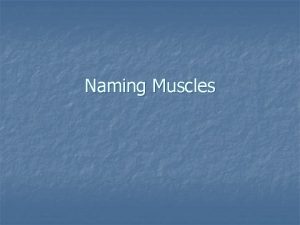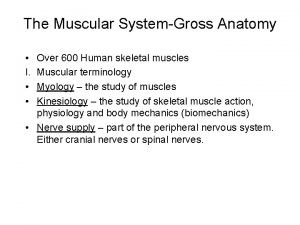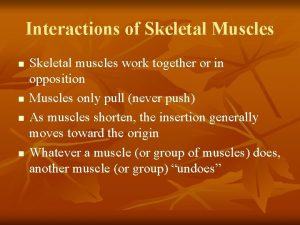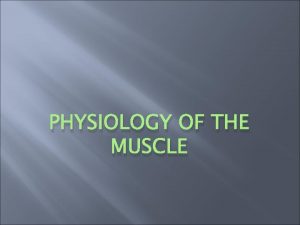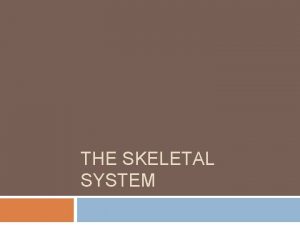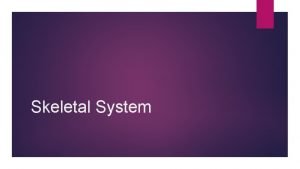Characteristics Used to Name Skeletal Muscles ALL MUSCLES











- Slides: 11

Characteristics Used to Name Skeletal Muscles

ALL MUSCLES l l l Help with posture, movement, or heat Cross at least 1 joint to create movement Shorten to contract ONLY Pull Have an origin that stays still and an insertion point that moves l Most muscles are antagonistic pairs (one muscle does an action, the other reverses it Ex/ Flexors and Extensors)

General Muscle Jobs/Categories l l l Fixators- muscles that help to hold a bone in position, Anchor an origin for another muscle Help with posture l l Prime Mover/agonistmain muscle in a group responsible for a movement Synergists- muscle(s) that are part of a team/group that produce the same movement Cross the same joint Antagonist- reverses the action of the prime mover. l Crosses same joint as prime mover on OPPOSITE side.

Naming Skeletal Muscles 1 – Location of the muscle 2 – Shape of the muscle 3 – Size of the muscle 4 – Direction/Orientation of the muscle fibers 5 – Number of Origins 6 – Location of the Attachments 7 – Action of the muscle

Muscles Named by Location: l frontalis – frontal bone l lateralis – lateral or on the side l tibialis anterior – front of tibia l supra – above l infra – below l sub - underneath

Muscles Named by Shape: l deltoid – triangle l teres – round l serratus –saw-toothe l trapezius – trapezoid l orbicularis – circular

Muscles Named by Size (relative to others in a group or region): l l l l maximus – largest minimis – smallest vastus - huge longus – longest brevis – short major – large minor – small Example: Pectoralis Major

Muscles Named by Direction of Fibers Direction/Orientation: l rectus (straight) - parallel to the muscle’s long axis ex: rectus abdominis l transversus (transverse) – at right angles to the muscle’s long axis l oblique – diagonal

Muscles Named for Number of Origins (fixed attachments): l biceps – two origins ex: biceps brachii l triceps – three origins ex: triceps brachii l quadriceps – four origins

Muscles Named for Origin and Insertion Points Origin and Insertion: sterno = sternum cleiodo = clavicle mastoid = location on the temporal bone sternocleiodomastoid muscle

Muscles Named for Action: l flexor carpi radialis – flexes wrist l abductor magnus – abducts the thigh l extensor digitorum – extends the fingers l Levator scapulae – elevates scapula
 Characteristics used to name muscles
Characteristics used to name muscles Name a line containing point a
Name a line containing point a Refractory period of smooth muscle
Refractory period of smooth muscle Microscopic anatomy of skeletal muscle
Microscopic anatomy of skeletal muscle What are major muscles
What are major muscles Skeletal muscles anterior view
Skeletal muscles anterior view Skeletal muscle organization
Skeletal muscle organization Patterns of fascicle organization
Patterns of fascicle organization What tissue forms membranes
What tissue forms membranes Major skeletal muscles
Major skeletal muscles Naming skeletal muscles
Naming skeletal muscles Anterior muscles
Anterior muscles



